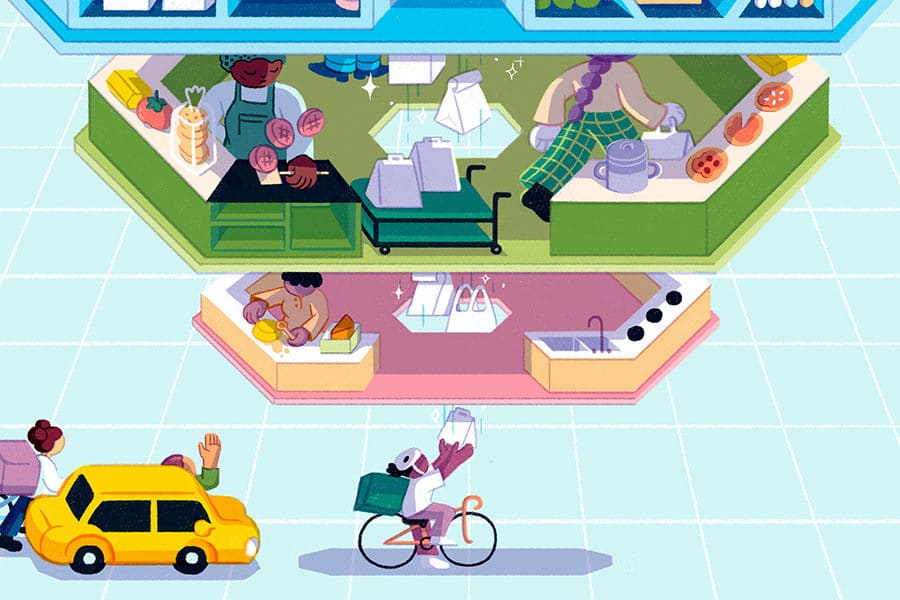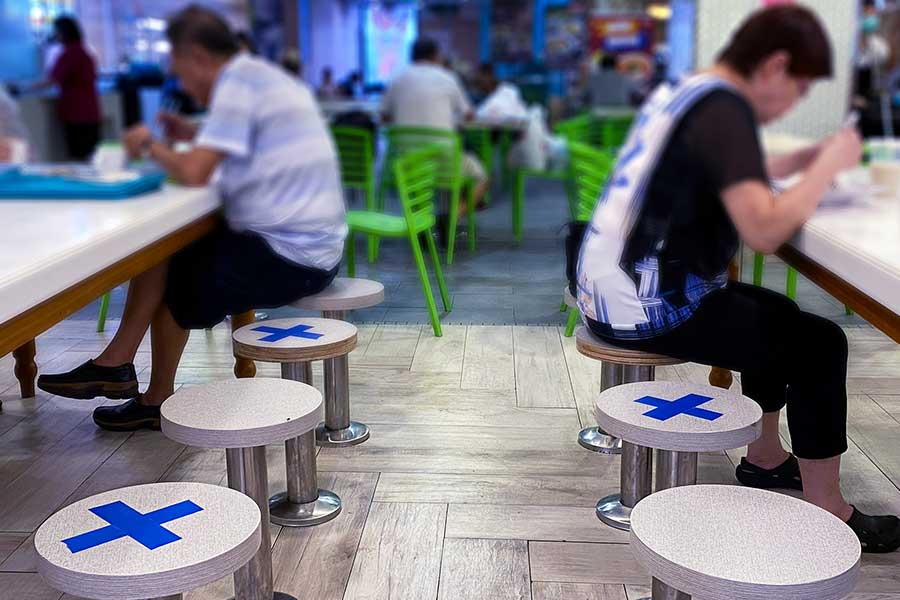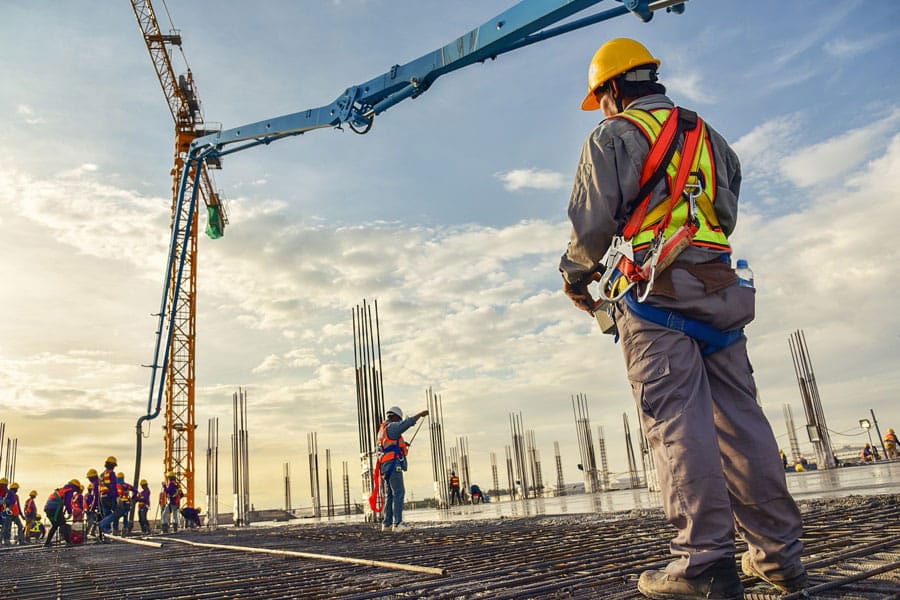The COVID-19 pandemic has led to many changes in the way the world constructs and uses buildings. From a host of new on-site safety regulations to a boom in the plastic barrier industry, companies across the globe have had to adjust to dramatic changes in consumer behavior.
Nowhere is this issue more critical than the hospitality industry, among the hardest hit by the pandemic. While restaurant design firms are adapting new construction standards to simplify flow and increase diners’ access to outdoor space, many consumers still prefer the dine-in experience at home, with roughly a third of consumers saying they’ve been ordering in more than usual since the beginning of the pandemic.
This boom in takeout and delivery, which financial research firm UBS projected in 2018 was on track to grow 13.5% annually, compared to just 3% growth in the overall restaurant industry, comes on the heels of a burgeoning concept that had already begun to gain traction prior to the pandemic: the ghost kitchen.
What is a ghost kitchen?
Although its name suggests a more spiritual—and, perhaps, spooky—source of nourishment, ghost kitchens initially sprung up to fill the gap between customers and restaurants in the emerging app-based delivery industry.
“There’s lots of different app technology that help facilitate food delivery,” said Kristen Barnett, chief operating officer at New York-based ghost kitchen startup Zuul. “Food couriers might use Grubhub, DoorDash, other third-party delivery apps, or their own native delivery platforms where consumers can place orders directly with restaurants.”
While initially these apps served to connect customers directly with local restaurants, delivery-only kitchens began to spring up as a result of growing consumer demand.
Despite their pre-pandemic origin, ghost kitchens—also known as cloud kitchens—have been experiencing a massive boom as consumers have migrated to more at-home dining experiences, with further growth ahead.
Ex-Uber Co-Founder and CEO Travis Kalanick, who resigned from his post at the ride-sharing company in 2017, has quietly laid the groundwork for a ghost kitchen startup, CloudKitchen. A number of other companies, like Reef Technologies, have moved to increase investment in the ghost kitchen concept as they pivot their post-pandemic strategies away from in-person dining.
“Ghost kitchens are flipping the restaurant model on its head,” Barnett said. “Especially with COVID, we’ve obviously seen a massive shift to delivery, but the trend was already alive and well.” The food service industry was already well into experimenting with growth strategies via delivery-only models, “because at this point you really can run a business through well-established digital channels,” Barnett said.
That’s where Zuul comes in. The company was started with the mission of connecting restaurants with pre-built spaces they can use to run delivery-only kitchens with minimum overhead and maximum flexibility.
Building for flexibility
Because of the malleable nature of the ghost kitchen concept, Barnett said that the Zuul build out and design teams have a highly specific checklist of priorities to address when creating a new space. Such priorities can inform contractors that specialize in restaurant and food-service construction with how to shift their business.
“What we’re looking for is connectivity,” she said. “We have to map out where the kitchens go, the flow of the space for food runners to move between the kitchens to pick up food. We have to understand where the dish pits are going to be for centralized dish washing services, as well as mark-out a space for a large, shared walk-in [refrigerator] where the restaurants are able to store various products.”
From there, Barnett said contractors then need to design and build out the dispatch center where workers are managing the outbound ordering from the restaurant. “It’s really building the nine kitchen suites that have hoods, hand-washing sinks, space for reach-in [refrigerators] and prep tables,” she said.
‘Ghost kitchens are flipping the restaurant model on its head.’
Kristen Barnett, director of strategy at New York-based ghost kitchen startup Zuul
Handling the logistical needs of multiple bustling restaurant kitchens means that Zuul designers must pay attention to the details of necessary constructed amenities like dish pits, trash rooms, storage and shared walk-in refrigerators—creating a solid infrastructural skeleton that clients can use to build their businesses on.
“We install a baseline set of equipment, which includes a six-burner stove, hand-washing sinks and a reach-in refrigerator,” Barnett said. “From there, it’s really a blank slate for them to bring in what they need, and we connect them with our partnership equipment provider that is able to work with them to fit out the space and then install any of their specialty equipment that they need. We just see a ton of variation in how the kitchen spaces are used that’s really driven by the restaurant and their menu.”
A new approach to culinary space
Barnett said that creating a ghost kitchen is easier than building out a conventional consumer-facing restaurant.
“With conventional restaurant construction, you’re looking at an expensive and long build out,” she said. “In a place like New York City that could be a million bucks or more. So, the ghost kitchen is a really cost-effective way for food entrepreneurs or chefs to grow and expand their business into new markets or more fully into these offsite-only channels.”
Restaurants interested in starting a delivery-only service via a ghost kitchen could choose to rent a kitchen via a Zuul membership, buying them access to the existing space, a process Barnett said typically takes four weeks or less. “They really just have to get the equipment and permits, and then they can get going immediately,” she said. “So, in that initial stage, it’s so different compared to traditional brick-and-mortar for restaurants.”
Barnett said that the types of spaces Zuul uses to create ghost kitchens vary. “Some are going to be full build outs,” she said, “but others are actually repurposing second gen space, like a food hall that is no longer in operation and can be easily converted into a ghost kitchen.”
When looking for spaces to transform, there are a number of necessary existing factors.
“We’re obviously going to be looking at the structure of the space and whether it would allow for proper ventilation from all of the restaurants that would be cooking within it,” Barnett said. “We also look for a number of means of egress throughout the space, so that we can facilitate all of the movement from food provider and the handoff with the couriers, as well as just general inbound and outbound flow of employees and others that work within the space.”
Once the space is built, Zuul’s main role is handling logistics and facilitating the handoffs between couriers and the runners who drop off the food from the various kitchens the space contains.
“We’re an infrastructure and service provider,” Barnett said. “We work with restaurants that manage their own teams to cook the food within their own kitchen suite, which is located within the larger ghost kitchen, where we have a large, shared walk-in dish washing services and a full expo and dispatch center that we operate.”
















